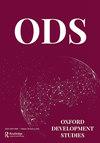在金融包容性地区,农村家庭债务可持续吗?来自印度喀拉拉邦三个地区的证据
IF 1.2
Q3 DEVELOPMENT STUDIES
引用次数: 2
摘要
摘要本文探讨普惠金融带来的制度变迁是否会导致家庭可持续债务管理。我们使用从印度喀拉拉邦农村3个地区的600个家庭收集的原始数据分析了家庭负债及其各个方面。我们发现超过一半的样本家庭负债。运用流量分析和存量分析,对农户的还款能力进行了评估。虽然基于利息和收入比较的流量分析表明债务是可持续的,但考虑到土地资产的非流动性,存量分析表明债务状况令人担忧。农业和非农业家庭似乎都陷入了债务陷阱。我们的计量经济分析表明,社会经济因素,如户主的教育程度和年龄、家庭收入的主要来源和家庭资产价值(不含土地),是家庭负债水平的重要决定因素。本文章由计算机程序翻译,如有差异,请以英文原文为准。
Is rural household debt sustainable in a financially included region? Evidence from three districts of Kerala, India
ABSTRACT This paper explores whether institutional change brought about by financial inclusion results in sustainable debt management by households. We analyze household indebtedness and its various dimensions using primary data collected from 600 households across 3 districts of rural Kerala in India. We find that more than half of the sample households are indebted. Using flow and stock analysis, we assess the repayment capacity of households. While the flow analysis based on interest and income comparison shows that debt is sustainable, the stock analysis indicates an alarming debt situation considering the illiquid nature of land assets. Both agricultural and non-agricultural households appeared to be caught in a debt trap. Our econometric analyses show that socio-economic factors like education and age of the household head, main source of household income and household asset value without land, are significant determinants of household level indebtedness.
求助全文
通过发布文献求助,成功后即可免费获取论文全文。
去求助
来源期刊

Oxford Development Studies
DEVELOPMENT STUDIES-
CiteScore
2.70
自引率
0.00%
发文量
20
期刊介绍:
Oxford Development Studies is a multidisciplinary academic journal aimed at the student, research and policy-making community, which provides a forum for rigorous and critical analysis of conventional theories and policy issues in all aspects of development, and aims to contribute to new approaches. It covers a number of disciplines related to development, including economics, history, politics, anthropology and sociology, and will publish quantitative papers as well as surveys of literature.
 求助内容:
求助内容: 应助结果提醒方式:
应助结果提醒方式:


